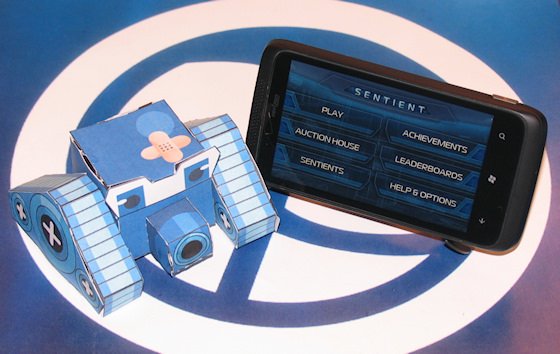Windows Phone Xbox Live Review: Fusion: Sentient


When Microsoft announced that downloadable Xbox 360 title Fusion: Genesis would receive a Windows Phone companion game, Fusion: Sentient, my eyes lit up. Sentient comes from Wahoo Studios, makers of some charming and creative XBLA titles. And what gamer doesn’t enjoy the promise of cross-platform connectivity? Imagine my surprise then when I finally played Sentient and discovered it to be a dull, arduous cash-in of a game.
While Fusion: Genesis on XBLA is a twin-stick shooter/RPG hybrid that takes place entirely in space, Fusion: Sentient attempts to flesh out the shared universe at ground level. The story involves a man, named Player - yes, that’s what they call him instead of using the player’s GamerTag or even just an interesting name. He’s an up-and-coming Machinist, a fellow who specializes in raising Sentients. In the Fusion universe, Sentients are living robots who can walk around and interact with people or fly alongside their spaceships. As the story progresses, an evil robot-faced lady continually tries to assassinate the hero and his personal Sentient, Cogita. It seems there is a secret weapon capable of destroying the universe, and she wants to unleash its awesome power.
Sentient’s story makes less and less sense as the game goes on. First, it’s told entirely through some of the most poorly-drawn digital comic panels ever – think Dead Space: Ignition bad. Not only is the art hideous and amateurish, but it poorly conveys the action between panels, resulting in frequent confusion. Worst of all, the story has next to nothing to do with the game itself. Player and Cogita work alone almost the entire time, and yet in the game, players always control a squad of five nameless Sentients. Player and Cogita are nowhere to be found. The disconnect between story and gameplay makes it hard to care about anything that happens in the game.
Perhaps if Fusion: Sentient’s gameplay was above par I could ignore the irrelevant narrative. It does initially show promise. Beards & Beaks previously adapted the real-time strategy genre to mobile phone, to mixed but enjoyable results. Sentient takes an entirely different approach to the same genre. Players control a squad of five mechs, battling other mechs over a series of missions. Along the way, your mechs level up, plus you gain new loot and mechs. Unfortunately, none of it works very well.
Sentient’s main problem is mission variety. Specifically, the complete and total lack of it. Every mission consists of three phases. In the first, players must capture the enemy’s ‘heart’ – basically a flag. In the next phase, you capture a generic artifact while defending the heart. The third phase is just like the second, but with two artifacts instead of one. Multiply that times 44 missions and you have the entire game. While there are eight different environments, maps never have any distinguishing characters to differentiate one from another, so every mission on a map looks and feels just like every other.

The developers throw in a few modifiers now and then in an attempt to alleviate the monotony: endless enemies, a time limit, reduced healing, or reduced field of vision. Every single modifier is a nuisance, decreasing the fun instead of enhancing it. Endless enemy missions in particular can be extremely unfair as the enemies overwhelm your small squad of robots.
Winning the more challenging missions usually comes down to grinding until your Sentients become strong enough to survive. Sentient includes some RPG elements, as your mechs gain experience and levels by defeating enemies. I’m all for RPG mechanics, and grinding can be fun when it’s done right. But the units in this game are completely disposable. There are only three classes (DPS, Tank, and Healer), each of which comes in five levels of quality: common, uncommon, rare, epic, and legendary. Once you gain the next level of a class you’re using (as a post-mission reward), you just sell or auction the old one and start leveling up the new guy. It’s hard to become attached to characters when the majority of the time you’ll just be getting rid of them anyway.
All the latest news, reviews, and guides for Windows and Xbox diehards.
The main benefit of leveling up is gaining access to better weapons, as every weapon is locked to a minimum level. Equipping Sentients with new guns is a complete pain though. To equip a gun, you select one of the 2-7 equippable slots on a mech. Some slots can use certain weapon types while other spots can’t; it’s never explained to the player. Once you’ve chosen a slot, all of the possible weapons it can use appear in a huge list. Scrolling left to right through the list takes longer and longer as you acquire new weapons. There are absolutely no sorting options, so every time it’s a slog through hordes of weapons as you search for a level-appropriate one. If you could auto-equip the best weapon for the mech’s level or at least jump to level-appropriate weapons, things would go much more smoothly. It seems like the developers put absolutely no thought into inventory management.

Fusion: Sentient is also a fairly unattractive game. The problem stems not from the mech models, which look good enough for a mobile title. Instead, the fog of war keeps things ugly. Unexplored areas are simply black. The majority of the time you’ll be pushing back the blackness as you explore each map in search of artifacts. There’s never a map that’s just filled in, nor do you spend much time on a map after filling it in. The pervasive blackness creates a sense that the maps are floating in the middle of nowhere. Games like Final Fantasy Tactics handle floating maps far more attractively.
A few more complaints: Fusion: Sentient’s loading times are excessive, ranging from 30 seconds to a minute at the start of each phase of a mission. That would be too annoying in a console title and it’s just ridiculous for a portable one. Out of my 12 or so hours of gameplay, at least 66 minutes of it was spent staring at loading screens!
Last, the unit pathfinding is extremely bad. The player’s own mechs cannot walk through each other. Whenever the lead mech walks into a corner, the four robots following him will box him in and keep him from moving. You have to manually select one of the obstructing robots and move him out of the way, and then quickly move the lead mech before one of the other guys fills in the place you’ve just cleared. Lots of times an individual or group of mechs will take extremely roundabout paths instead of the shortest route, too.
Connectivity

Fusion: Genesis
As mentioned before, Fusion: Sentient connects with Fusion: Genesis on Xbox 360. Mechs from the phone game can be auctioned or gifted to console players. It’s necessary to do so (or just sell them in-game for a much lower amount), as you can only hold a limited number of mechs at one time. I go into greater detail about the connectivity and its benefits here. I’ll just add that during my playtime, the auction server was frequently unavailable. This often forced me to stop playing and come back to the game later since I didn’t want to just sell my Sentients for scrap. Players of the now-delisted Crackdown: Project Sunburst will remember its similarly inexcusable server woes.
Achievements
Fusion: Sentient has that most dreaded thing: glitched Achievements. ‘Repo Man’ and ‘Reaper’s Understudy’ require players to complete 10 missions by collecting all artifacts and 10 missions by defeating all enemies, respectively. Unfortunately the game’s tracking of progress towards these Achievements is broken. Some players have managed to get ‘Repo Man’ (not me), but ‘Reaper’s Understudy’ remains completely unattainable at present.
Overall Impression
Given Wahoo/NinjaBee’s previous track record of quality XBLA games, I can only assume they weren’t given enough time with Fusion: Sentient to make a decent game. Hopefully they will at least fix the broken Achievements and add Fast App Switching, which would alleviate loading times upon resuming. But even without those problems, Sentient would still be a long, boring grind with horrendous inventory management. Fusion: Genesis, on the other hand, comes from a different developer – Starfire Studios – and is far more worthwhile. To learn more about the XBLA game, check out my full review at Co-Optimus.
Fusion: Sentient costs $2.99 and has a free trial. If you value your time or money, try to avoiding picking it up here at the Marketplace. Fusion: Genesis for Xbox 360 costs 800 Microsoft Points ($10) right here.
Update
Ater more than a year, the game finally received a patch in early 2013 to fix the broken Achievement and add Fast App Switching support. Thank goodness!


Paul Acevedo was formerly a Games Editor at Windows Central. A lifelong gamer, he has written about videogames for over 15 years and reviewed over 350 games for our site. Follow him on Twitter @PaulRAcevedo. Don’t hate. Appreciate!
